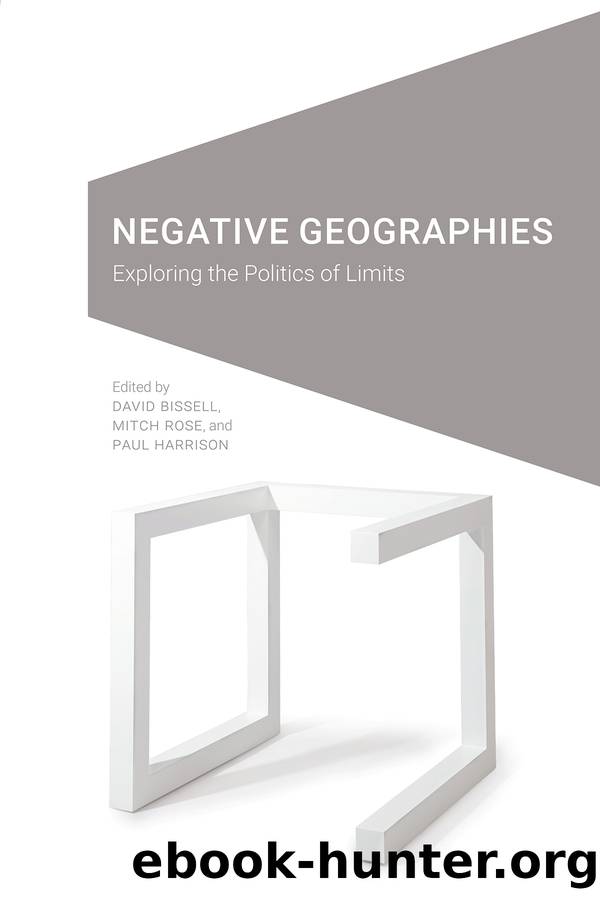Negative Geographies by David Bissell & Mitch Rose & Paul Harrison

Author:David Bissell & Mitch Rose & Paul Harrison [Bissell, David & Rose, Mitch & Harrison, Paul]
Language: eng
Format: epub
Tags: SOC052000 Social Science / Media Studies, SOC015000 Social Science / Human Geography
Publisher: University of Nebraska Press
Exhausting Places
This second section expands this bodily focus by broadening out to consider how place is a central but overlooked concern for understanding exhaustion geographically. Places are, of course, more than just meaningful locations (Agnew 1987). They have multiple kinds of capacities to do things. Rather than seeing places as an inert backdrop upon which the social life of humans plays out, cultural geographers have had an ongoing preoccupation with understanding the varied ways that different places have their own capacities and powers to act on different bodies in different ways. Foregrounding place, then, invites us to consider the affecting nature of places; in other words, how they act and impress upon us. A recognition of the agentive capacities of place develops our understanding of exhaustion because it invites us to think about how places themselves are centrally implicated in exhaustion, rather than exhaustion resulting just from the activities that bodies undertake. Of course place is quietly present in different guises in the first section of this chapter, such as the place of the industrial factory in Rabinbachâs account, or the place of the home in Berlantâs inference of domestic labor. But the focus was on bodily practices themselves and the exhausting labors of performing them. In this section I trace two distinct but related bodies of work that highlight how places exhaust. First, I describe how a key thread of twentieth-century urban theory foregrounds the capacity of places to exhaust. Second, I describe how a thread of avant-garde practice has more playfully explored how places might be exhausted. While these bodies of work are preoccupied with quite different problems, what joins them is a more passive sense of bodies in the thrall of affecting places.
Writing at the turn of the twentieth century, at a time of dramatic social change, Georg Simmel was fascinated by the rapid growth of cities, stimulated by the development of industry and the associated rural to urban migration. He was especially interested in understanding the impact of this rapid transformation on city dwellers themselves. In his landmark essay âThe Metropolis and Mental Life,â Simmel describes how the intensification of âviolent stimuliâ in the new metropolis depletes peopleâs energy (2002, 11). He writes, âjust as an immoderately sensuous life makes one blasé because it stimulates the nerves to their utmost reactivity until they finally can no longer produce any reaction at all, so, less harmful stimuli, through the rapidity and the contradictoriness of their shifts, force the nerves to make such violent responses, tear them about so brutally that they exhaust their last reserves of strength and, remaining in the same milieu, do not have time for new reserves to formâ (2002, 14). Inhabiting the same era that Rabinbachâs account of bodily exhaustion focuses on, it is perhaps no surprise that Simmel draws on a similar âthermodynamicâ understanding of bodies depicted in terms of their relative energy levels. However, what is distinctive about Simmelâs account is that it is the sensory stimulation of the city itself that is exhausting, rather than the labor of bodily practice.
Download
This site does not store any files on its server. We only index and link to content provided by other sites. Please contact the content providers to delete copyright contents if any and email us, we'll remove relevant links or contents immediately.
Cecilia; Or, Memoirs of an Heiress — Volume 1 by Fanny Burney(32446)
Cecilia; Or, Memoirs of an Heiress — Volume 2 by Fanny Burney(31875)
Cecilia; Or, Memoirs of an Heiress — Volume 3 by Fanny Burney(31861)
The Great Music City by Andrea Baker(31550)
We're Going to Need More Wine by Gabrielle Union(18976)
All the Missing Girls by Megan Miranda(15604)
Pimp by Iceberg Slim(14403)
Bombshells: Glamour Girls of a Lifetime by Sullivan Steve(13983)
Talking to Strangers by Malcolm Gladwell(13238)
Norse Mythology by Gaiman Neil(13221)
Fifty Shades Freed by E L James(13165)
For the Love of Europe by Rick Steves(13154)
Mindhunter: Inside the FBI's Elite Serial Crime Unit by John E. Douglas & Mark Olshaker(9215)
Crazy Rich Asians by Kevin Kwan(9176)
The Lost Art of Listening by Michael P. Nichols(7413)
Enlightenment Now: The Case for Reason, Science, Humanism, and Progress by Steven Pinker(7244)
The Four Agreements by Don Miguel Ruiz(6643)
Bad Blood by John Carreyrou(6560)
Weapons of Math Destruction by Cathy O'Neil(6156)
